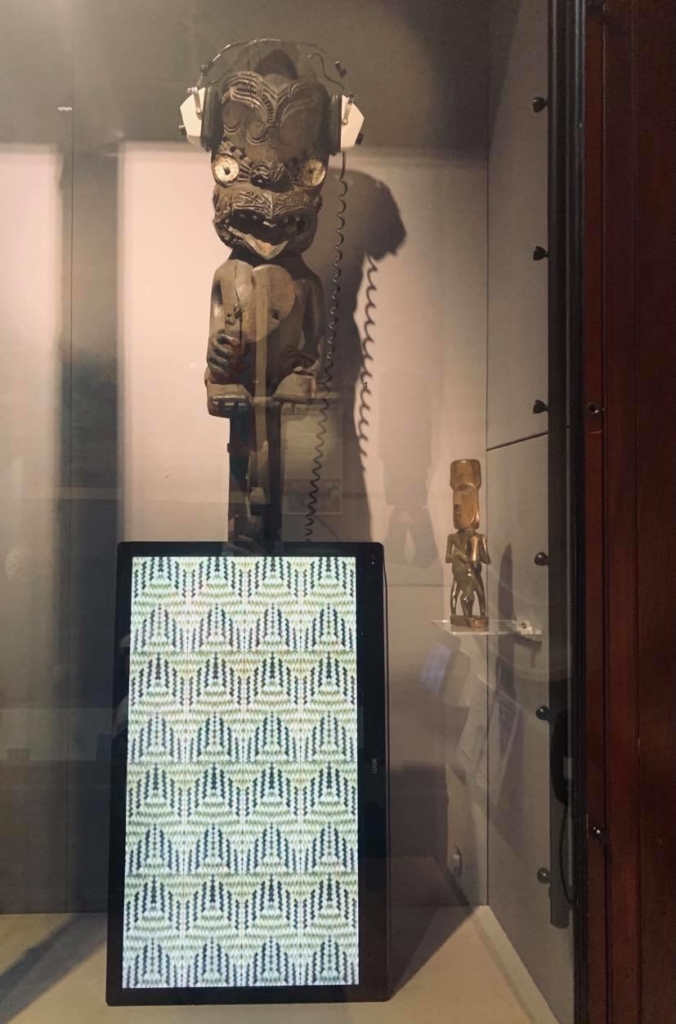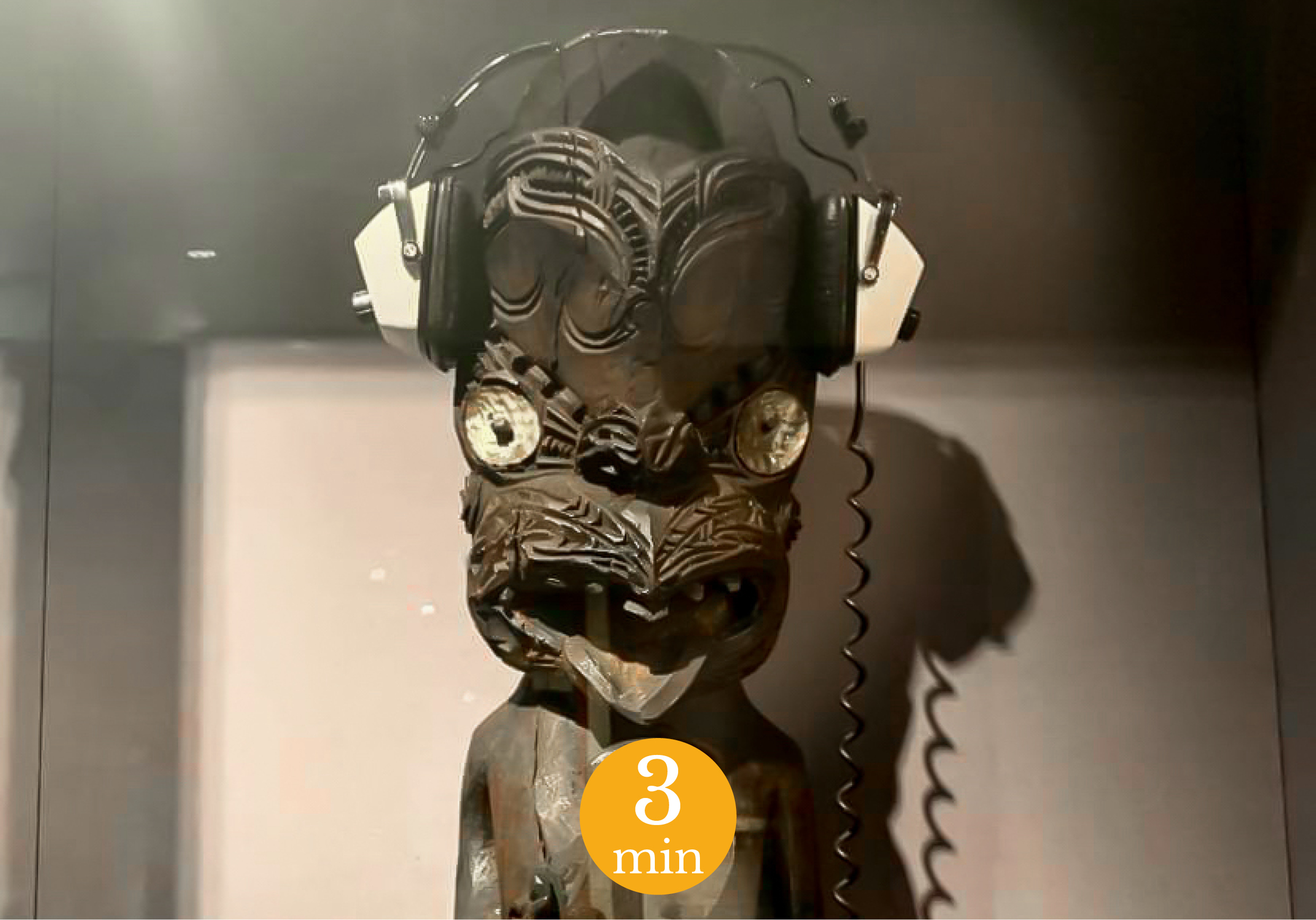Since the 1980s, European museums holding Oceanian objects in their collections have undertaken numerous projects to revise the ways in which these objects are exhibited and managed. Inviting contemporary Oceanian artists in residence to propose a new reading of the old collections is one of the methods developed. These initiatives are also a way of giving more visibility to these artists who are still largely unknown and rarely exhibited in European institutions. A major project in this regard is Pasifika Styles, organised at the Museum of Archaeology and Anthropology in Cambridge (UK) between May 2006 and February 2008. Lisa Reihana, a member and founder of the Pacific Sisters collective, whose work In Pursuit of Venus [infected] we have already mentioned in previous articles, created the work He tautoko for the occasion, which CASOAR is now focusing on.

Lisa Reihana, He Tautoko, 2006, Cambridge University Museum of Archeology and Anthropology.
© Lisa Reihana, photograph by Clémentine Débrosse
Pasifika Styles is part residency programme, part exhibition and part series of events. Leading the project are Amiria Salmond, a curator at the Cambridge Museum, and Rosanna Raymond, an artist and poet of Samoan and New Zealand descent living in London as part of the Pacific Sisters. The two women proposed a selection of thirty-six artists from Aotearoa New Zealand in order to achieve a broad representation of the local art scene, including artists of Māori, Pākeha and various diasporic backgrounds, both young artists and more experienced ones. Some artists had the opportunity to travel to Cambridge to study the collections and work on their own work, as was the case for Lisa Reihana.
Born in 1964 in Aotearoa New Zealand, Lisa Reihana is of ngāpuhi, ngāti hine and ngāi tū ancestry. Trained at the University of Auckland, she is developing a multi-disciplinary practice. Her work explores notions of identity and history, colonisation and gender through a variety of media: video, photography, installation, costume and textile design, body adornment, sculpture and writing.1 Representing Aotearoa New Zealand at the Venice Biennale in 2017 with the work In Pursuit of Venus [infected], and regularly exhibited around the world, she has now become a major international contemporary Oceanian artist.
The work created by Lisa Reihana for Pasifika Styles starts from her encounter with an object in the Cambridge Museum's collections, a tekoteko, a carved wooden human figure that was part of the façade of a house. From this tekoteko, Lisa Reihana has created a multi-media installation that also includes a video projected on a screen, an audio recording accessible through headphones, all placed in a historical display case in the museum. The title of the work is He tautoko, an expression in te reo māori meaning 'a supporter' or 'an advocate'.2 In the centre of the display case, the tekoteko wears headphones which play the sounds of Māori carver Lyonel Grant at work carving wood. The visitor is also invited to listen to this recording through a second pair of headphones placed outside the window. On the screen is a video made by Lisa Reihana after her visit to the Cambridge museum collections in November 2005.3
Lisa Reihana selected this object specifically because it is from Nga Puhi in the Bay of Islands, Lisa Reihana's father region of origin. She thus wished to establish an 'iwi connection' with this object4, to use her words, i.e. to re-establish family ties with this object, 'iwi' being important extended family units in Māori thought. This intention is explained by the fact that the tekoteko is part of the taonga, "tangible and intangible entities"5 of great value in Māori thought, passed down from generation to generation. Taonga are not just objects, they are seen as relatives, family members in their own right. For Lisa Reihana, the taonga preserved at Cambridge were extracted and separated from their context, both physically, temporally and culturally.6 In particular, this tekoteko has a troubled and controversial history: it was donated to the museum by Anatole von Hügel (1854-1928), who received it from his father, Baron Carl von Hügel (1795-1870), who had himself travelled to Aotearoa New Zealand in the 1830s. However, it is not known how, why or from whom von Hügel obtained the tekoteko.7 This controversial history is recorded in the registers and cartels that are dedicated to this tekoteko. Lisa Reihana's gesture thus makes it possible to "give voice" to the tekoteko through the sounds produced by Lyonel Grant and the projected film.8 The installation also forms a way of readjusting the narrative from the point of view of inter-generational Māori relationships. "Rather than being didactic, the artist's intention is to encourage people to think for themselves about the possible meanings created by the repositioning of objects in the museum's collections."9 Thus, the Pasifika Styles project is a concrete example of the possibility of constructing "relational objects"10 within a museum, linking people and objects, past and present, through the expression of material and immaterial Oceanic cultures.
Depuis 2008, l’œuvre de Lisa Reihana est régulièrement présentée dans les galeries permanentes du musée d’archéologie et d’anthropologie de Cambridge.
Pour découvrir davantage des œuvres de Lisa Reihana : https://www.lisareihana.com/
Marion Bertin
Cover picture: Lisa Reihana, He Tautoko, 2006, Cambridge University Museum of Archeology and Anthropology. © Lisa Reihana, photograph by Clémentine Débrosse
1 HOEBERIGS, Zoe, « Lisa Reihana », AWARE, sd. URL : https://awarewomenartists.com/artiste/lisa-reihana/, dernière consultation le mardi 28 juin 2022.
2 Selon le Māori Dictionary, URL : https://maoridictionary.co.nz/, dernière consultation le mardi 28 juin 2022.
3 REIHANA, Lisa, « He Tautoko (2006): A new media installation », in Raymond, Rosanna (dir.), Salmond, Amiria (dir.), Pasifika Styles. Artists inside the Museum, Cambridge : University of Cambridge Museum of Archeology and Anthropology & Dunedin : Otago University Press, 2008 : 49-53.
4 Ibid., p. 51.
5 RENARD, Lisa. « Deux manteaux māori à bordures géométriques (kaitaka) de Nouvelle-Zélande Aotearoa du XIXe siècle au musée du Quai Branly – Jacques Chirac », Journal de la Société des Océanistes, 152, 2021 : 137-154.
6 Reihana, 2008, op. cit.
7 THOMAS Nicholas, The Return of curiosity. What museums are good for in the 21st century, Londres : Reaktion Books, 2016, pp. 124-125.
8 Reihana, 2008, op. cit., p. 51.
9 HERLE, Anita, « Relational Objects: Connecting People and Things Through Pasifika Styles », International Journal of Cultural Property, 15, 2008, p. 164.
10 Ibid., p. 176.
Bibliography:
- HERLE, Anita, « Relational Objects: Connecting People and Things Through Pasifika Styles », International Journal of Cultural Property, 15, 2008 :159-179.
- HOEBERIGS, Zoe, « Lisa Reihana », AWARE, sd. URL : https://awarewomenartists.com/artiste/lisa-reihana/, dernière consultation le mardi 28 juin 2022.
- RAYMOND, Rosanna (dir.), SALMOND, Amiria (dir.), Pasifika Styles. Artists inside the Museum, Cambridge : University of Cambridge Museum of Archeology and Anthropology & Dunedin : Otago University Press, 2008.
- REIHANA, Lisa, « He Tautoko (2006): A new media installation », in Raymond, Rosanna (dir.), Salmond, Amiria (dir.), Pasifika Styles. Artists inside the Museum, Cambridge : University of Cambridge Museum of Archeology and Anthropology & Dunedin : Otago University Press, 2008 : 49-53.
- RENARD, Lisa. « Deux manteaux māori à bordures géométriques (kaitaka) de Nouvelle-Zélande Aotearoa du XIXe siècle au musée du Quai Branly – Jacques Chirac », Journal de la Société des Océanistes, 152, 2021 : 137-154.
- THOMAS, Nicholas, The Return of curiosity. What museums are good for in the 21st century, Londres : Reaktion Books, 2016.

1 Comment so far